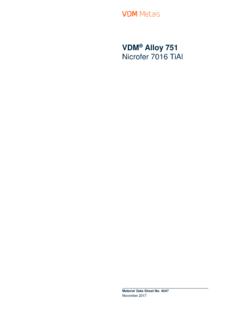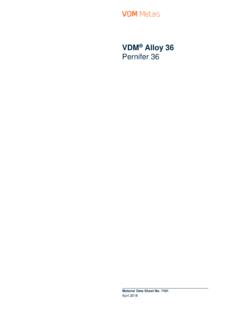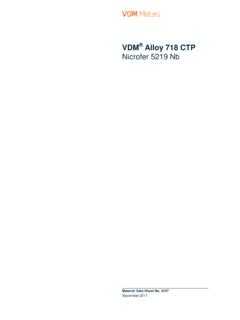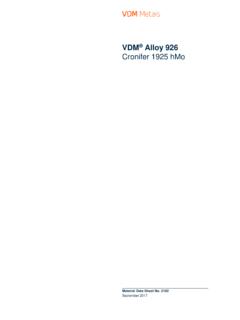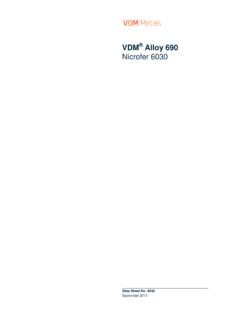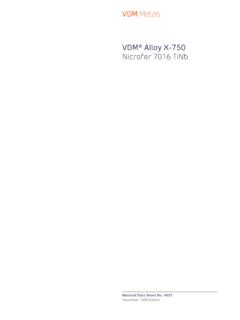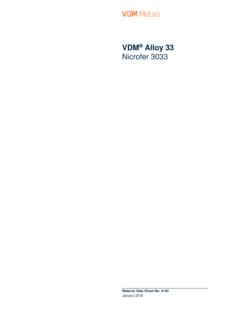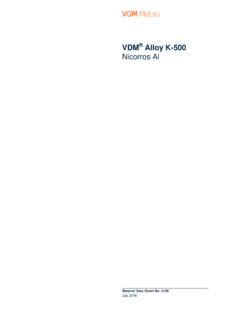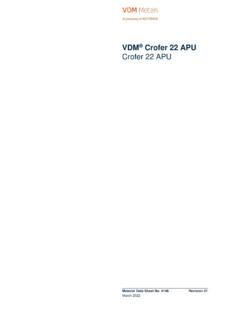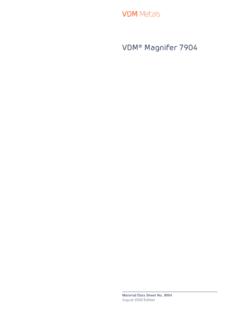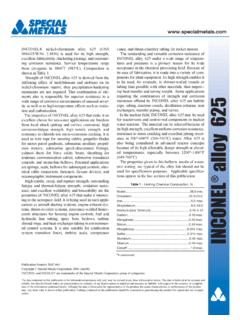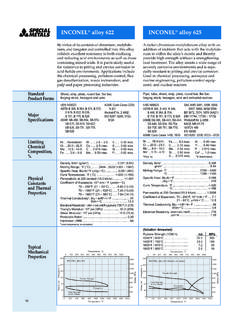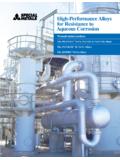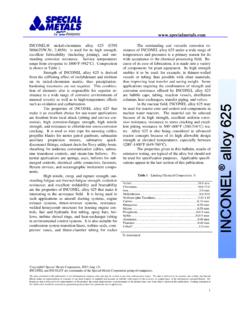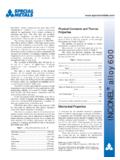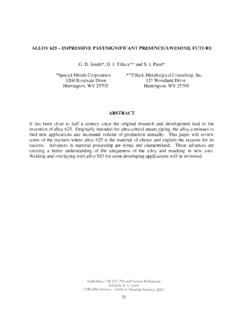Transcription of VDM Alloy 625 Nicrofer 6020 hMo
1 VDM Alloy 625 Nicrofer 6020 hMo Data Sheet No. 4118 Revision 03 May 2018 May 2018 VDM Alloy 625 2 VDM Alloy 625 is a nickel-chromium-molybdenum-niobium Alloy with excellent resistance to a variety of corrosive media. In the soft annealed condition (grade 1; annealed at 950 to 1,050 C (1,742 to 1,922 F)), the Alloy is used for wet corrosion applications and is approved by T V for pressure vessels in a temperature range from -196 to 450 C (-320 to 842 F). For high temperature applications above 600 C (1,112 F), the solution annealed variant (grade 2; annealed at 1,080 to 1,160 C (1,976 to 2,120 F)) is generally used. The strength of VDM Alloy 625 can be enhanced by heat treatment. VDM Alloy 625 is also approved by ASME in both the grade 1 and grade 2 conditions for sections I, III, VIII and XII at temperatures defined in ASME Section IID (temperature limits vary by construction code).
2 VDM Alloy 625 in the soft annealed condition (grade 1) is characterized by: Exceptional resistance to pitting, crevice cor-rosion, erosion and intergranular corrosion Immunity to chloride-induced stress corrosion cracking Good resistance to mineral acids such as ni-tric, phosphoric, sulfuric and hydrochloric acid Good resistance to alkalis and organic acids Good mechanical properties VDM Alloy 625 in the solution annealed condition (grade 2) is characterized by: Excellent creep strength above about 600 C (1,112 F) Good resistance to many types of hot gas cor-rosion, particularly chlorination Designations Standard Material designation EN - NiCr22Mo9Nb ISO NC22 DNb UNS N06625 AFNOR NC22 DNb Standards Product form DIN DIN EN ISO ASME ASTM (SAE) AMS VdT V NACE Others Rod, bar 17744 17752 10228 SB 446 B 446 B 564 E 112 2154 C 5666 499 Sheet, plate 17744 17750 6208 9722 15156-3 SB 443 B 443 5599 499 MR 0175 MR 0103 API 5LD Strip 17744 2662 6208 SB 443 B 443 5599 5869 499 MR 0175 API 5LD Wire 17744 17753 10088-3 10095 Table 1 Designations and standards VDM Alloy 625 Nicrofer 6020 hMo May 2018 VDM Alloy 625 3 Chemical composition Ni Cr Fe C1) Mn Si Co Al Ti P S Mo Nb + Ta Min.
3 58 21 8 Max. 71 23 5 1 10 1) The chemical analysis may differ slightly in some elements in other specifications and contain additional elements; according to DIN EN 10095 for example, the value for C is to and the value for Cu is max; UNS specifies C as wt-% max. and other elements are also different. Table 2 Chemical composition ( ) according to VdT V data sheet 499 Physical Properties Density Melting range Relative magnetic permeability at 20 C (68 F) g/cm3 ( lb/in3) 1,290-1,350 C (2,354-2,462 F) (Maximum) Temperature Specific heat Thermal conductivity Electrical resistivity Modulus of elasticity Coefficient of thermal expansion C F JKg K Btulb F Wm K Btu insq. ft h F cm GPa 103 ksi 10-6K 10-6 F 20 68 125 209 100 212 496 86 126 202 7 200 392 521 127 195 300 572 538 16 129 190 400 762 555 131 185 500 932 573 132 178 600 1,112 620 131 170 8 700 1,292 654 130 162 800 1,472 663 129 153 900 1,652 677 128 142 9 1,000 1,832 684 128 128 1,100 2,012 695 1,200 2,192 705 Table 3 Typical physical properties at room temperature and elevated temperatures May 2018 VDM Alloy 625 4 Microstructural properties VDM Alloy 625 has a cubic face centered lattice.
4 Mechanical properties The following properties are applicable to VDM Alloy 625 at room temperature and elevated temperatures in the indi-cated size ranges. Temperature Yield strength Rp Tensile strength Rm Elongation A C F MPa ksi MPa ksi % 20 68 330 730 35 100 212 290 600 87 200 392 265 580 300 572 260 560 400 752 260 540 450 842 255 37 530 500 932 265 650 550 1,022 260 645 600 1,112 255 37 640 650 1,202 245 625 700 1,292 240 610 750 1,382 225 570 800 1,472 215 450 850 1,562 200 29 350 900 1,652 190 250 1,000 1,832 100 120 Table 4 Minimum short-time mechanical properties at room temperature and at elevated temperatures for VDM Alloy 625 according to VdT V data sheet 499 (above 500 C typical values) May 2018 VDM Alloy 625 5 Product form Dimensions mm Yield strength Rp MPa Tensile strength Rm MPa Elongation A % Strip, sheet 7 400 830 30 Sheet, plate 50 380 760 35 Forging < 160 380 760 30 160 330 730 35 Table 5 Minimum mechanical properties at room temperature according to VdT V data sheet 499 Temperature Time yield limit Rp h Rp h Creep rupture strength Rm/104 h Rm/105 h C F MPa MPa MPa MPa 600 1,112 390 162 440 302 650 1,202 215 145 275 190 700 1,292 128 78 170 110 750 1,382 68 42 98 62 800 1,472 38 23 57 34 850 1,562 20 11 30 14 900 1,652 11 5 14 6 Table 6 Typical yield limit and creep rupture strength values of solution annealed VDM Alloy 625 (grade 2) ISO V-notch impact values Average values at room temperature ak: 125 J/cm2 KV.
5 100 J Corrosion resistance Optimum corrosion resistance can only be obtained if the material is in the correct metallurgical condition and possess-es a clean structure. Under these circumstances In the soft annealed condition VDM Alloy 625 (grade 1) has excellent corrosion resistance to a variety of corrosive media: Excellent resistance to pitting and crevice corrosion in chloride-containing media Virtual immunity to chloride-induced stress corrosion cracking High resistance to corrosion attack by mineral acids such as nitric, phosphoric, sulfuric, and hydrochloric acid; as well as by concentrated alkalis and organic acids, both under oxidizing as reducing conditions Very good resistance in seawater and brackish water, even at elevated temperatures High resistance to intergranular corrosion after welding and heat treatment High resistance to erosion corrosion In the solution annealed variant VDM Alloy 625 (grade 2) is highly resistant to many corrosive gas atmospheres: Good resistance to carburizing and scaling under static and cyclic conditions Resistance to nitriding Good resistance to gases containing halogens, and hydrogen chloride May 2018 VDM Alloy 625 6 Material Material No.
6 CPT CCP PREN (pitting resistance equivalent number)1) 316 Ti 15 <0 24 904 L 45 25 37 VDM Alloy 926 70 40 47 VDM Alloy 33 85 40 50 VDM Alloy 625 75 55 51 1) PRE = 1 (% Cr) + 3,3 (% Mo) + 20 (% N) Table 7 Critical pitting temperature (CPT) and critical crevice temperature (CCT) of VDM Alloy 625 (grade 1) in comparison to high alloyed stainless steels in 10 % FeCl3, x 6 H2O Applications The soft annealed version of VDM Alloy 625 (grade 1) is used in the oil and gas industry, the chemical process indus-try, marine engineering and environmental engineering. Typical applications include: Equipment for the production of super phosphoric acid Plants for the treatment of radioactive waste Production pipe systems and linings of risers in oil production Offshore industry and seawater exposed equipment Sea water piping in shipbuilding Stress corrosion cracking resistant compensators Furnace linings The solution annealed variant of VDM Alloy 625 (grade 2) is used for high temperature applications up to 1,000 C (1,832 F), acc.
7 To ASME Code for Pressure Vessels. Typical applications include: Flaring systems in refineries and offshore platforms Recuperators and compensators for hot exhaust gases VDM FM 625 is used as a matching filler metal for corrosion-resistant coatings of less resistant steels (overlay weld-ing). Typical applications include: Components in the oil and gas extraction Superheater tubes in waste incineration plants May 2018 VDM Alloy 625 7 Fabrication and heat treatment VDM Alloy 625 can readily be hot- and cold-worked and machined. However, machines are required for any operation that meet the high mechanical properties. Heating Workpieces must be clean and free of any contaminants before and during heat treatment. Sulfur, phosphorus, lead and other low-melting-point metals can lead to damages when heat treating VDM Alloy 625. Sources of such contami-nants include marking and temperature-indicating paints and crayons, lubricating grease and fluids, and fuels.
8 Fuels should contain as little sulfur as possible. Natural gas should contain less than of sulfur. Heating oil with a sulfur content of maximum is also suitable. Electric furnaces are to be preferred due to precise temperature control and freedom from contamination due to fuel. The furnace atmosphere should be set between neutral and slight-ly oxidising, and should not change between oxidising and reducing. Direct flame impingement needs to be avoided. Hot working VDM Alloy 625 may be hot worked in the temperature range 1,150 to 900 C (2,100 to 1,650 F) with subsequent rapid cooling down in water or by using air. The workpieces should be placed in the furnace heated to hot working tem-perature in order to heat up. Once the hot working temperature has been reached again, a retention time of 60 minutes for each 100 mm (4 in) of workpiece thickness is recommended.
9 Afterwards, workpieces should be removed immedi-ately and formed during the stated temperature window. If the material temperature falls to 950 C (1,742 F), the work-piece must be reheated. Heat treatment after hot working is recommended in order to achieve optimum microstructure and corrosion resistance. Cold working Cold working should be carried out on annealed material. VDM Alloy 625 has a higher work hardening rate than aus-tenitic stainless steels. This must be taken into account during design and selection of forming tools and equipment and during the planning of the forming processes. Intermediate annealing may be necessary at high degrees of cold work-ing deformation. After cold working with more than 15 % of deformation the material should be soft annealed (grade 1) or solution annealed (grade 2). Heat treatment VDM Alloy 625 is used in applications where the operating temperatures are below 600 C (1,112 F) in the soft an-nealed condition (grade 1).
10 The soft annealing is carried out at temperatures of 950 to 1,050 C (1,742 to 1,922 F); a temperature of 980 C (1,796 F) is preferred. For applications above 600 C (1,112 F), the solution annealed variant of VDM Alloy 625 (grade 2), which provides optimized creep strength, is used. The solution heat treatment should be carried out in the temperature range between 1,080 C and 1,160 C (1,976 and 2,120 F), preferably at 1,120 C (2,048 F). Water quenching should be carried out rapidly to achieve optimum corrosion characteristics. Workpieces of less than 3 mm ( in) thickness can be cooled down using air nozzles. The workpiece has to be put into the pre-heated furnace. The furnace should be heated up to the maximum annealing temperature. The cleanliness requirements listed under Heating must be complied with. May 2018 VDM Alloy 625 8 Descaling and pickling Oxides of VDM Alloy 625 and discoloration adjacent to welds are more adherent than on stainless steels.
